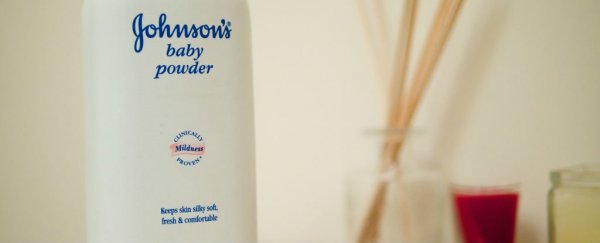Pharmaceutical giant Johnson & Johnson has been ordered to pay out the largest amount yet in a series of lawsuits brought against it for not adequately warning against potential risks associated with the use of talcum powder.
While the scientific consensus behind the claim is still undecided, a state court jury in St. Louis, Missouri, determined that there was enough evidence to find the global company was liable for a 62-year-old American woman's development of ovarian cancer.
Lois Slemp was awarded a payout of $US5.4 million in compensation, with Johnson & Johnson being slugged with a further $US105 million in punitive damages.
The manufacturer of the talc considered to have caused the cancer, Imerys Talc, was found to also hold a percentage of responsibility and ordered to pay $US50,000.
Slemp's case has made headlines for its sizeable sum, but hers is just the latest in a series of cases against the company based on the allegation that Johnson & Johnson failed to warn people that using talcum powder near their genitals could cause ovarian cancer.
In early 2016, several months after plaintiff Jacqueline Fox passed away from ovarian cancer, Johnson & Johnson were required to pay $US72 million in punitive and actual damages to the Fox family.
More than 3,000 cases against the company have been filed across the US by people who believe not only that toiletry products based on talcum powder raise the risk of women developing ovarian cancer, but that Johnson & Johnson know it.
Not all of the plaintiff's cases have been successful, with Johnson & Johnson persuading a New Jersey court in 2016 to throw out two cases based on a lack of scientific evidence.
"The court's decision today appropriately reflects the science and facts at issue in this litigation," a spokeswoman for Johnson & Johnson, Carol Goodrich, said in a statement at the time.
"Science, research, clinical evidence and decades of studies by medical experts around the world continue to support the safety of cosmetic talc."
While a number of juries might be convinced that Johnson & Johnson aren't behaving as ethically as it should, the research on the matter hasn't made a convincing case for the scientific community.
Talc is a mineral made mostly of magnesium and silicates, often found underground in deposits mixed with small amounts of asbestos.
While this sounds bad, ever since 1973, the asbestos is required to be removed long before it makes its way into plastic bottles to sprinkle on the parts of your (or your baby's) body you want to keep dry.
Back in the early 1970s, tissue from patients with ovarian and cervical tumours was found to contain particles of talc, leading to speculation that there was a link between the use of the powder and the cancers.
Nearly half a century later - not to mention numerous studies - research on the matter both shows and don't show a relationship between cancer and use of talcum powder.
While the World Health Organisation's International Agency for Research on Cancer identifies talc that contains asbestos as carcinogenic, its official position on the asbestos-free product is "not classifiable as to its carcinogenicity in humans" if inhaled or dusted on your skin.
On the other hand, they do concede that if used on your 'undercarriage', there is a possibility of it being carcinogenic based on their interpretation of the evidence.
So where does that leave us? For day-to-day use, groups like the American Cancer Society say that if you're concerned, stop using it, but otherwise there really isn't much of a reason to believe it will significantly increase the risk of developing cancer.
Yet there is a difference between your informed choice based on the evidence (or lack thereof), and an organisation's promoted use of their product, at least where the law is concerned.
And no doubt we'll be seeing more lawsuits of this kind - earlier this year, an Italian court awarded a man a pension based on his belief that mobile phone use as part of his job was responsible for the development of a benign tumour in his head, in spite of scant scientific evidence linking health concerns with the use of mobile phones.
While Johnson & Johnson cite research on their website that presents their talc as safe, legal representatives for the plaintiffs have claimed that internal communications within the company show that it isn't quite as convinced as its own marketing alleges.
"The documents are truly offensive. The company has known forever and has been creating a defense strategy for decades," Slemp's lawyer Jim Onder told the Independent Journal Review.
With so many court cases still pending, and Johnson & Johnson filing appeals in the face of handing out millions in compensation, it's likely the company could be changing marketing tactics in the future, not to mention its labelling.
As for the mixed results in the research, perhaps time will tell whether talc really does increase our chances of developing cancer, or if we can keep powdering our bits down below without worrying about any potential risks to our health.
